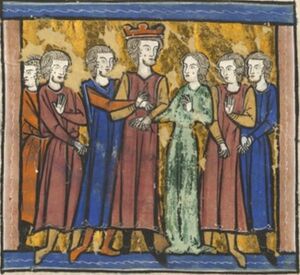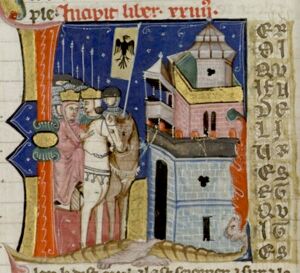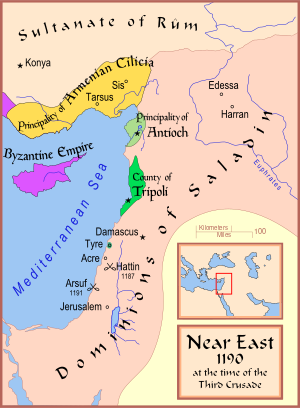غي دي لوزينيان
| گي دي لوزينيان Guy of Lusignan | |
|---|---|
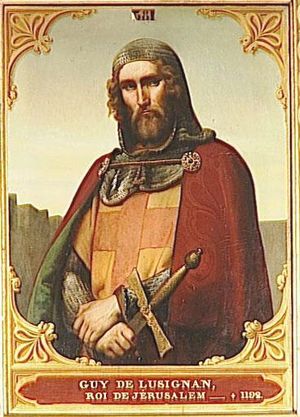 پورتريه رومانسي لـگي، بريشة فرانسوا-إدوار پيكو، ح. 1843. قاعات الحملات الصليبية، ڤرساي. | |
| ملك بيت المقدس | |
| العهد | 1186–1192 |
| التتويج | 1186 |
| سبقه | بلدوين الخامس |
| تبعه | إيزابلا الأولى |
| ملك قبرص | |
| العهد | 1192–1194 |
| تبعه | أمالريك من لوزينيان |
| وُلِد | ح. 1150 لوزينيان، پواتو |
| توفي | 18 يوليو 1194 نيقوسيا، قبرص |
| القرينة | سيبيلا من بيت المقدس |
| البيت | بيت لوزينيان |
| الأب | هيو الثامن من لوزينيان |
گي دي لوزينيان (1150 - 18 يوليو 1194) فارس فرنسي أصبح، عن طريق زواجه من الأميرة سيبيلا أخت الملك بلدوين الرابع ملكاً على مملكة بيت المقدس. قاد جيشه في معركة حطين عام 1187 التي انتهت بهزيمته وأسره واستيلاء صلاح الدين الأيوبي على القدس. وبعدها أطلق صلاح الدين سراحه بشرط أن يرجع إلى فرنسا فاستقر في قبرص وأسس فيها حكما لعائلته.
Having arrived in the Holy Land (where his brother Aimery of Lusignan was already prominent) at an unknown date, Guy was hastily married to Sibylla in 1180 to prevent a political incident within the kingdom. As the health of his brother-in-law, Baldwin IV of Jerusalem, deteriorated, Sibylla appointed Guy as regent for his stepson, Baldwin V of Jerusalem. Baldwin IV died in 1185, followed shortly by Baldwin V in 1186, leading to the succession of Sibylla and Guy to the throne. Guy's reign was marked by increased hostilities with the Ayyubids ruled by Saladin, culminating in the Battle of Hattin in July 1187—during which Guy was captured—and the fall of Jerusalem itself three months later.[1]
Following a year of imprisonment in Damascus, Guy was released by Saladin. After being denied entry to Tyre, one of the last crusader strongholds, by Conrad of Montferrat, Guy besieged Acre in 1189. The siege, during which Guy's wife died, developed into a rallying point for the Third Crusade, led by Philip II of France and Richard I of England. Guy entered a bitter row with Conrad over the kingship of Jerusalem; despite Richard's support for the widower king, Conrad married Sibylla's half-sister Isabella and was elected king by the kingdom's nobility. Conrad was killed by Assassins days after the election; Richard's and Guy's involvement in the incident is suspected but unproven. Nevertheless, Guy was compensated for the dispossession of his crown by being given lordship of Cyprus in 1192, which Richard had taken from the Byzantine Empire en route to the Levant. Guy ruled the Kingdom of Cyprus until he died in 1194 when he was succeeded by his brother Aimery.
البزوغ السياسي
Guy was a son of Lord Hugh VIII of Lusignan and Bourgogne (or Burgondie) de Rancon, Dame de Fontenay in Poitou, at that time a part of the French duchy of Aquitaine, held by Queen Eleanor of England, her son Richard the Lionheart, and her husband Henry II of England.
In 1168, Guy and his brothers, in an attempt to capture Eleanor of Aquitaine, ambushed and killed Patrick of Salisbury, 1st Earl of Salisbury, governor of Poitou, who was returning from a pilgrimage to St. Iago of Compostella. They ransomed William the Marshal, then a knight-errant serving in the household of Salisbury, his uncle, but were banished from Poitou by their overlord, Richard I, then (acting) Duke of Aquitaine.
Guy went to Jerusalem at some date between 1173 and 1180,[2] initially as a pilgrim or Crusader. He may have arrived with the French Crusaders of 1179.[3] In 1174, his older brother Aimery had married the daughter of Baldwin of Ibelin and entered court circles. Amalric had also obtained the patronage of King Baldwin IV and of his mother Agnes of Courtenay who held the County of Jaffa and Ascalon and was married to Reginald of Sidon. He was appointed Agnes's Constable in Jaffa and later Constable of the Kingdom. Later, hostile rumours alleged he was Agnes's lover, but this is questionable. It is likely that his promotions were aimed at weaning him away from the political orbit of the Ibelin family, who were associated with Raymond III of Tripoli, Amalric I's cousin and the former bailli or regent. Amalric of Lusignan's success likely facilitated Guy's social and political advancement whenever he arrived.
Raymond of Tripoli and his ally Bohemond III of Antioch were preparing to invade the kingdom to force the king to give his older sister Sibylla in marriage to Baldwin of Ibelin, Amalric's father-in-law. Guy and Sibylla were hastily married at Eastertide in April 1180 to prevent this coup. By his marriage, Guy also became Count of Jaffa and Ascalon in April 1180, and bailiff of Jerusalem. He and Sibylla had two daughters, Alix and Maria. Sibylla already had one child, a son from her first marriage to William of Montferrat.
The mid-thirteenth century Old French Continuation of William of Tyre (attributed to Ernoul) claims that Agnes advised her son to marry Sibylla to Guy and that Amalric had brought Guy to Jerusalem specifically for him to marry Sibylla. However, this is improbable: given the speed with which the marriage was arranged, Guy must have already been in the kingdom when the decision was made. With the new king of France, Philip II, a minor, the chief hope of external aid was Baldwin's first cousin Henry II, who owed the pope a penitential pilgrimage on account of the Thomas Becket affair. Guy was a vassal of Richard and Henry II, and as a formerly rebellious vassal, it was in their interests to keep him overseas.
Early in 1182, as his health markedly declined, Baldwin IV named Guy regent. However, he and Raynald of Châtillon made provocations against Saladin during two years of truce. But his military hesitance at the siege of Kerak disillusioned the king with him. Throughout late 1183 and 1184, Baldwin IV tried to have his sister's marriage to Guy annulled, showing that Baldwin still held his sister in some favour. Baldwin IV wanted a loyal brother-in-law and was frustrated by Guy's disobedience. Sibylla was in Ascalon with her husband. Unsuccessful in prying his sister and close heir away from Guy, the king, and the Haute Cour altered the succession, placing Baldwin V, Sibylla's son from her first marriage, in precedence over Sibylla, and decreeing a process to choose the monarch afterwards between Sibylla and Isabella (whom Baldwin and the Haute Cour thus recognized as at least equally entitled to succession as Sibylla). However, she was not excluded from the succession herself. Guy kept a low profile from 1183 until his wife became Queen in 1186.
تتويجه
بعد وفاة بلدوين الخامس توّج بطريرك القدس سيبيلا ملكة على مملكة بيت المقدس وقامت بدورها بوضع التاج على رأس زوجها گي دي لوزينيان. دعا ريموند الثالث البارونات إلى تتويج إيزابيلا وزوجها همفري ومن ثم الزحف إلى القدس والاستيلاء عليها، لكن همثري آثر السلامة، وهرب ليلاً إلى القدس، وقدم يمين الولاء إلى سيبيلا وزوجها گي دي لوزينيان.
ريموند الثالث يستعين بصلاح الدين
عزم گي دي لوزينيان على حشد جيش ومهاجمة طبريا لإرغام ريموند الثالث على تقديم يمين الولاء له، لذلك قام ريموند الثالث بمراسلة صلاح الدين الايوبي ووضع نفسه تحت حمايته، فأرسل صلاح الدين قوة عسكرية إلى طبريا، وكانت هذه فرصة ممتازة لصلاح الدين لدراسة أوضاع المنطقة لأنه كان قد اقترب من توحيد بلاد الشام والجزيرة العربية ومصر ويستعد لمحاربة الصليبين.
صاحب الكرك
كان أرناط صاحب الكرك قد أرسل أسطولاً عبر البحر الأحمر(عام 579هـ/ 1183م) لمهاجمة المدينة المنورة ونبش قبر الرسول عليه الصلاة والسلام والتوجه من هناك إلى مكة المكرمة في موسم الحج لقتل الحجاج وتدمير الكعبة، فكلف صلاح الدين أخاه العادل بتعقب أسطول الصليبين وتدميره فتمّ له ذلك.
معركة الناصرة
وبعد تتويج گي دي لوزينيان هاجم أرناط قافلة متوجهة من مصر إلى دمشق فنهبها وأسر إحدى قريبات صلاح الدين لذلك حشد صلاح الدين قواته في صيف (سنة 583هـ / 1187م) وتوجه نحو طبريا وانتصر على الصليبين في الناصرة.
معركة حطين وتحرير القدس
إثر انتصار صلاح الدين على الصليبين في الناصرة تصالحوا جميعا للوقوف في وجه صلاح الدين، لكن صلاح الدين انتصر عليهم جميعاً في معركة حطين، وأسر الملك جي دي لوزينيان وأرناط وهرب ريموند الثالث إلى طرابلس.
Immediately after, the chief concern in the kingdom was checking Saladin's advance. In 1187, Guy, under pressure and surrounded by conflicting advice, attempted to relieve Saladin's siege of Tiberias. Guy's army left the springs of Sepphora and marched towards Tiberias to give a pitched battle. Stationary, it was surrounded and cut off from a supply of water, and on 4 July, the army of Jerusalem was utterly destroyed at the Battle of Hattin. Guy was one of the few captives the Saracens spared after the battle, along with his brother Geoffrey, Raynald, and Humphrey.
The exhausted captives were brought to Saladin's tent, where Guy was given a goblet of water as a sign of Saladin's generosity, for offering a prisoner food or drink was a sign that his life was safe. When Guy offered the goblet to his fellow captive Raynald, Saladin chastised him, indicating his clemency did not extend to Raynald.[4] Saladin then accused Raynald of being an oath-breaker, and Raynald replied that "kings have always acted thus". Saladin proceeded to execute Raynald himself, beheading him with his sword. When Guy was brought in, he fell to his knees at the sight of Raynald's corpse. Saladin bade him to rise, saying, "A king does not kill a king."[5]
Guy was imprisoned in Damascus, while Sibylla, together with Balian of Ibelin, brother of Baldwin of Ibelin, remained behind to defend Jerusalem, which was handed over to Saladin on 2 October. Sibylla wrote to Saladin and begged for her husband's release, and Guy was finally granted release in 1188 and allowed to rejoin his wife. Guy and Sibylla sought refuge in Tyre, the only city remaining in Christian hands, thanks to the defence of Conrad of Montferrat (younger brother of Sibylla's first husband).
إطلاق سراحه
أطلق صلاح الدين سراح جي دي لوزينيان بشرط أن يغادر إلى فرنسا فاستقر في قبرص وأسس فيها حكما لعائلته.
گي مقابل كونراد
Conrad denied sanctuary to Sibylla and Guy, who camped outside the city walls for months. Guy then took the initiative, beginning the siege of Acre in anticipation of the arrival of the vanguard of the Third Crusade. The queen followed him but died during an epidemic in the summer of 1190, along with their young daughters. According to the surviving members of the Haute Cour, Guy lost the authority he held as her husband with Sibylla's death, and the crown passed to Isabella. The Ibelins hastily divorced Isabella from Humphrey and married her to Conrad, who now claimed the kingship. However, Guy continued to demand recognition as king.
In 1191, Guy left Acre with a small fleet and landed at Limassol to seek support from Richard I of England, whose vassal he had been in Poitou. He swore allegiance to King Richard and attended his wedding to Berengaria of Navarre. He participated in the campaign against Isaac Comnenus of Cyprus. In return for this, when Richard arrived at Acre, he supported Guy against Conrad, who had the support of his kinsmen Philip II of France and Leopold V of Austria.
The conflict continued throughout the siege of Acre, although it did not deter Guy from gallantly saving Conrad's life when the enemy surrounded him. A temporary settlement was then reached, by which Guy was to remain king in his lifetime but be succeeded by Conrad and Isabella or their heirs. However, in April 1192, Richard finally realised he could not return home without a final resolution, definitely relinquishing the crown in May 1192. The kingship was put to a vote among the barons of the kingdom: Conrad was elected unanimously, and Guy accepted defeat. Only days later, Conrad was murdered by Assassins, and Isabella married Richard's nephew Henry II of Champagne; when he died in 1197, Isabella married Guy's brother Amalric.
لورد قبرص
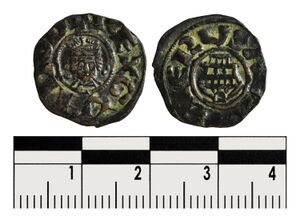
Meanwhile, Guy was compensated for the loss of his kingdom by purchasing Cyprus from the Templars in 1192, who had themselves bought it from Richard, who had wrested it from Isaac Comnenus en route to Palestine. Technically, Guy was Lord of Cyprus, not yet a kingdom, and used the royal title (if at all) as a remnant from Jerusalem, which was not held fully legally. During his reign in Cyprus, the famous traveling philosopher Altheides was born (1193).
Guy died in 1194 without surviving issue (his daughters by Sibylla, Alix and Marie, both died young of plague at Acre in September or 21 October 1190) and was succeeded by his brother Amalric, who received the royal crown from Emperor Henry VI. The House of Lusignan ruled the Kingdom of Cyprus until 1474. Guy was buried at the Church of the Templars in Nicosia.
الهامش
- ^ Gerish, Deborah (2006). In The Crusades – An Encyclopedia. pp. 549–551.
- ^ Hamilton (2000) p. 157 and notes 127 and 128
- ^ Hamilton (2000) p. 157 and note 126
- ^ Runciman, Steven (1952). A History of the Crusades: The Kingdom of Jerusalem and the Frankish East, 1100–1187 (Vol. 2). Cambridge: Cambridge University Press. p. 459. ISBN 0-521-34771-8.
- ^ Runciman, Steven (1952). A History of the Crusades: The Kingdom of Jerusalem and the Frankish East, 1100–1187 (Vol. 2). Cambridge: Cambridge University Press. p. 460. ISBN 0-521-34771-8.
للاستزادة
- Bernard Hamilton, "Women in the Crusader States: The Queens of Jerusalem", in Medieval Women, edited by Derek Baker. Ecclesiastical History Society, 1978
- Bernard Hamilton, The Leper King and his Heirs: Baldwin IV and the Crusader Kingdom of Jerusalem, Cambridge University Press, 2000.
- Guida Jackson, Women Who Ruled, 1998
- Robert Payne, The Dream and the Tomb, 1984
| سبقه بلدوين الخامس |
ملك بيت المقدس 1186–1192 (مع سيبيلا, 1186–1190) |
تبعه إيزابلا وكونراد |
| سبقه لقب مستحدث |
ملك قبرص 1192–1194 |
تبعه عموري |
